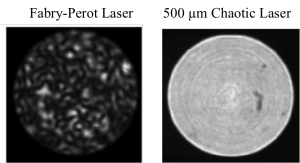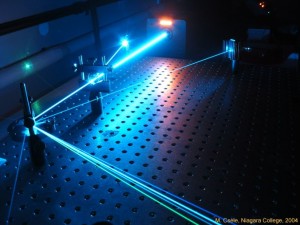When you hear the word “laser,” what comes to mind? Red streams of light in science fiction movies? The pointer that a professor uses in class? True, these are all examples of lasers, but lasers are also crucial components of a wide range of products, including printers, surgical equipment, and manufactured goods. One of the most critical roles that lasers play is in biomedical imaging. However, traditional lasers do not provide enough detail for sophisticated medical applications.
Led by physics professor Hui Cao and postdoctoral associate Brandon Redding, a team of researchers across several departments at Yale decided to join forces in order to address this deficiency in the marketplace. The team devised a commercially practical semiconductor laser for clearer medical imaging.

Michael A. Choma, assistant professor of diagnostic radiology, pediatrics, and biomedical engineering, provided guidance on the clinical requirements and demands for this next-generation biomedical imaging device. Meanwhile, associate professor of electrical engineering Minjoo L. Lee produced the laser’s semiconductor wafer using an extremely accurate crystal growth mechanism. The other major collaborators were A. Douglas Stone, professor and chair of applied physics, and graduate student Alexander Cerjan, who used theoretical modeling to test and optimize the shape of the laser for maximum efficiency. Cao and Redding facilitated the various aspects of the project, designing and completing the fabrication process.
The lead researchers emphasized that collaboration was a driving force behind this project. “This is a very good example of how combining expertise can help create a more optimal product,” Cao said. “By working with other departments, we were able to follow the entire process of product design, beginning with understanding consumer demand, theoretically modeling ideas, and growing the materials to ultimately fabricate and test the laser,” Redding added.

The guiding research question was how to create a light source for superior imaging that is bright like a laser but that does not generate speckle. Speckle is a grainy pattern that is produced by the high spatial coherence of ordinary lasers. Coherence is the factor that differentiates lasers from other forms of light by concentrating all of the energy into one stream.
Previously, Cao had discovered that a special type of laser, a random laser, did not produce a high degree of the interfering speckle. However, a random laser cannot be commercialized because it is based on an impractical liquid dye that needs to be replaced every several hours. Cao’s new laser corrects problems with this earlier design by using semiconductor material instead of a liquid, making it friendlier for practical use. Using semiconductor material, a solid, is preferable for use in the field because it does not require replenishing and is simpler to handle. Additionally, the new semiconductor laser uses a chaotic cavity design that increases light reflection in comparison to a random laser, which is another important quality for optimal laser functioning. This special “D shape” development is easier to model than the previous random laser design, reduces speckle, and maximizes light reflection, all beneficial factors for biomedical imaging apparatuses.
The team is now navigating the patenting process and looks forward to improving the design of its new laser even further. Opportunities for interdisciplinary work continue to arise — students at the business school are interested in investigating the commercial viability of the product.
Researchers often debate whether fundamental or application-based research is more of a priority. However, Cao’s laser demonstrates how both fundamental and applied research can come together for a greater goal. “We are now able to apply the unique characteristics determined in our fundamental research to a useful product,” Cao said. Redding agreed: “It is exciting how once we answered the fundamental science questions, the technology was ready to be transitioned for real-world applications.”
Cover Image: Image courtesy of Wikimedia Commons.
